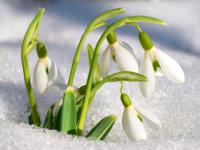Flower Spotlight: Snowdrop
It’s the little flower that could! Snowdrops are typically the first garden flower to bloom — they emerge in late winter or early spring, sometimes when snow is still on the ground! These flowers are hardy and can withstand cold temperatures and even bloom in freezing conditions down to -25 degrees Fahrenheit. Because of this, snowdrop blooms are associated with strength, new growth and the ability to overcome challenges!
The snowdrop’s scientific name, galanthus, comes from the Greek words gala (milk) and anthos (flower), referencing the pure white appearance of the flower. The perfect white petals are associated with purity and innocence in some cultures, while other cultures see them as a symbol of hope and rebirth.
Whether you indulge in the language of flowers or not, there is no denying that snowdrop blooms are beautiful and can be a great addition to your own garden! They are small plants, meaning they look best planted in groups of threes or fours near pathways or in elevated gardens.
Snowdrops are bulb plants that need to be planted in the fall in cool, rich, and well-drained soil. Make sure to put them in an area that receives full sunlight in the spring. Snowdrops also grow rapidly in woodland-type areas because ants help them disperse seeds across landscapes. Wherever they bloom, snowdrops return yearly as long as the winter lows reach at least 20 degrees Fahrenheit but not lower than negative 30.
Did you know that the snowdrop is the secondary birth flower of January? Yes, January has two birth flowers! While the carnation is a beautiful and common flower to find in everything from weddings to mixed arrangements; the snowdrop is less likely to appear in a bouquet but keep your eye out for them poking through the ground soon!







